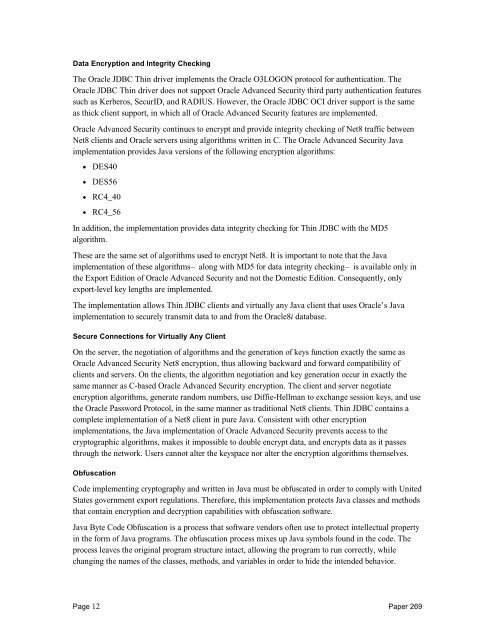Oracle 8i Security: New Features and Secure Solutions - CGISecurity
Oracle 8i Security: New Features and Secure Solutions - CGISecurity
Oracle 8i Security: New Features and Secure Solutions - CGISecurity
You also want an ePaper? Increase the reach of your titles
YUMPU automatically turns print PDFs into web optimized ePapers that Google loves.
Data Encryption <strong>and</strong> Integrity Checking<br />
The <strong>Oracle</strong> JDBC Thin driver implements the <strong>Oracle</strong> O3LOGON protocol for authentication. The<br />
<strong>Oracle</strong> JDBC Thin driver does not support <strong>Oracle</strong> Advanced <strong>Security</strong> third party authentication features<br />
such as Kerberos, SecurID, <strong>and</strong> RADIUS. However, the <strong>Oracle</strong> JDBC OCI driver support is the same<br />
as thick client support, in which all of <strong>Oracle</strong> Advanced <strong>Security</strong> features are implemented.<br />
<strong>Oracle</strong> Advanced <strong>Security</strong> continues to encrypt <strong>and</strong> provide integrity checking of Net8 traffic between<br />
Net8 clients <strong>and</strong> <strong>Oracle</strong> servers using algorithms written in C. The <strong>Oracle</strong> Advanced <strong>Security</strong> Java<br />
implementation provides Java versions of the following encryption algorithms:<br />
• DES40<br />
• DES56<br />
• RC4_40<br />
• RC4_56<br />
In addition, the implementation provides data integrity checking for Thin JDBC with the MD5<br />
algorithm.<br />
These are the same set of algorithms used to encrypt Net8. It is important to note that the Java<br />
implementation of these algorithms— along with MD5 for data integrity checking— is available only in<br />
the Export Edition of <strong>Oracle</strong> Advanced <strong>Security</strong> <strong>and</strong> not the Domestic Edition. Consequently, only<br />
export-level key lengths are implemented.<br />
The implementation allows Thin JDBC clients <strong>and</strong> virtually any Java client that uses <strong>Oracle</strong>’s Java<br />
implementation to securely transmit data to <strong>and</strong> from the <strong>Oracle</strong><strong>8i</strong> database.<br />
<strong>Secure</strong> Connections for Virtually Any Client<br />
On the server, the negotiation of algorithms <strong>and</strong> the generation of keys function exactly the same as<br />
<strong>Oracle</strong> Advanced <strong>Security</strong> Net8 encryption, thus allowing backward <strong>and</strong> forward compatibility of<br />
clients <strong>and</strong> servers. On the clients, the algorithm negotiation <strong>and</strong> key generation occur in exactly the<br />
same manner as C-based <strong>Oracle</strong> Advanced <strong>Security</strong> encryption. The client <strong>and</strong> server negotiate<br />
encryption algorithms, generate r<strong>and</strong>om numbers, use Diffie-Hellman to exchange session keys, <strong>and</strong> use<br />
the <strong>Oracle</strong> Password Protocol, in the same manner as traditional Net8 clients. Thin JDBC contains a<br />
complete implementation of a Net8 client in pure Java. Consistent with other encryption<br />
implementations, the Java implementation of <strong>Oracle</strong> Advanced <strong>Security</strong> prevents access to the<br />
cryptographic algorithms, makes it impossible to double encrypt data, <strong>and</strong> encrypts data as it passes<br />
through the network. Users cannot alter the keyspace nor alter the encryption algorithms themselves.<br />
Obfuscation<br />
Code implementing cryptography <strong>and</strong> written in Java must be obfuscated in order to comply with United<br />
States government export regulations. Therefore, this implementation protects Java classes <strong>and</strong> methods<br />
that contain encryption <strong>and</strong> decryption capabilities with obfuscation software.<br />
Java Byte Code Obfuscation is a process that software vendors often use to protect intellectual property<br />
in the form of Java programs. The obfuscation process mixes up Java symbols found in the code. The<br />
process leaves the original program structure intact, allowing the program to run correctly, while<br />
changing the names of the classes, methods, <strong>and</strong> variables in order to hide the intended behavior.<br />
Page 12 Paper 269










